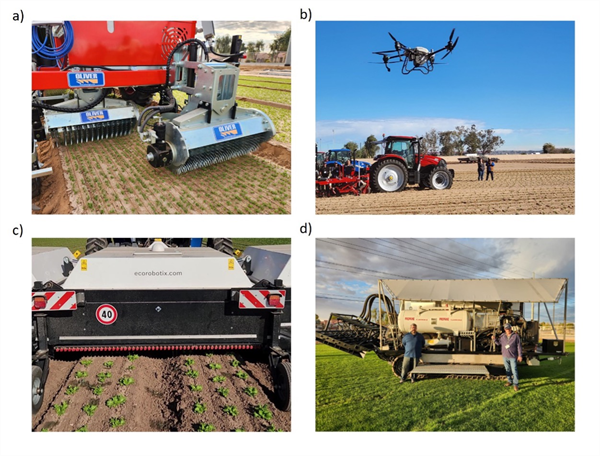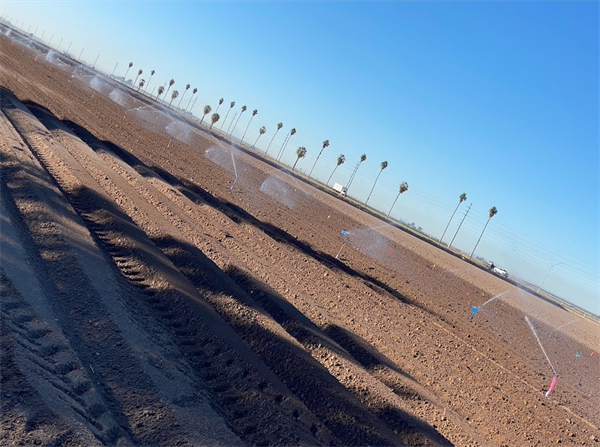
In arid and semi-arid regions, water is our first limiting factor in a crop production system, followed closely by bio-available nitrogen (N). Thus, our management of water and N are critically important to produce a healthy crop with good yields and quality.
Water and nutrient demands coincide with the fruiting cycle and efficient management of irrigation water and plant nutrients is enhanced by tracking crop development in the field. The use of heat units (HUs) with 86/55 oF upper and lower thresholds can be applied to warm season crops in the desert Southwest in relation to the thermal environmental impacts on the development of all crop systems (Brown, 1989), including chiles, (Figures 1 and 2).
Crop Phenology Relationship to Water and Nitrogen Demand
Phenological guidelines have been developed for many crops, including New Mexico type chiles (Soto-Ortiz and Silvertooth, 2007 and Silvertooth, et al, 2010; Figure 1). This phenological guideline can be used to identify or predict important stages of crop development that impact physiological requirements. For example, a phenological guideline can help identify stages of growth in relation to crop water use (consumptive use) and nutrient uptake patterns (Figure 3).
This information allows growers to improve the timing of water and N inputs to improve production efficiency. For some crops or production situations HU based phenological guidelines can be used to project critical dates such as harvest or crop termination. Many other applications related to crop management (e.g., pest management) can be derived from a better understanding of crop growth and development patterns.

Figure 1. Typical relationship between the rate of plant growth and development
and temperature. Growth and development ceases when temperatures decline
below the lower temperature threshold (A) or increase above the upper
temperature threshold (C). Growth and development increases rapidly when
temperatures fall between the lower and upper temperature thresholds (B).

Figure 2. Basic phenological guideline for irrigated New Mexico-type chiles.
References
Brown, P. W. 1989. Heat units. Bull. 8915, Univ. of Arizona Cooperative Extension, College of Ag., Tucson, AZ.
Silvertooth, J.C., P.W. Brown, and S. Walker. 2010. Crop Growth and Development for Irrigated Chile (Capsicum annuum). University of Arizona Cooperative Extension Bulletin No. AZ 1529
Soto-Ortiz, R. and J.C. Silvertooth. 2007. A Crop Phenology Model for Irrigated New Mexico Chile (Capsicum annuum L.) The 2007 Vegetable Report. Jan 08:104-122.
At events and in the halls of the Yuma Agricultural Center, I’ve been hearing murmurings predicting a wet winter this year…
As the Yuma Sun reported last week, “The storms of Monday, Aug. 25 [2025], were the severest conditions of monsoon season so far this year in Yuma County, bringing record-rainfall, widespread power outages and--in the fields--disruptions in planting schedules.”
While the Climate Prediction Center of the National Weather Service maintains its prediction of below average rainfall this fall and winter as a whole, the NWS is saying this week will bring several chances of scattered storms.
These unusually wet conditions at germination can favor seedling disease development. Please be on the lookout for seedling disease in all crops as we begin the fall planting season. Most often the many fungal and oomycete pathogens that cause seedling disease strike before or soon after seedlings emerge, causing what we call damping-off. These common soilborne diseases can quickly kill germinating seeds and young plants and leave stands looking patchy or empty. Early symptoms include poor germination, water-soaked or severely discolored lesions near the soil line, and sudden seedling collapse followed by desiccation.
It is important to note that oomycete and fungal pathogens typically cannot be controlled by the same fungicidal mode of action. That is why an accurate diagnosis is critical before considering treatments with fungicides. If you suspect you have seedling diseases in your field, please submit samples to the Yuma Plant Health Clinic or schedule a field visit with me.
National Weather Service Climate Prediction Center: https://www.cpc.ncep.noaa.gov/
National Weather Service forecast: https://forecast.weather.govAt the 2024 Southwest Ag Summit Field Demo a couple of weeks ago, many of the latest technologies were demonstrated in the field. Most were related to pest control. Several of the technologies demonstrated or on display at the event are brand new to the Yuma, AZ area. The new technologies presented included an implement designed for cultivating high density crops (Fig. 1a), a field scale drone sprayer (10.6 gal) (Fig. 1b), a high precision spot sprayer (Fig. 1c) and a self-propelled machine that disinfests soil prior to planting using steam. Updated versions of laser weeders, camera-guided cultivators and smart, automated in-row weeding machines (mechanical) were also demonstrated. Over the next several years, it will be interesting to watch the technologies in this space evolve further and become integrated into our cropping systems.

Fig. 1. New pest control technologies demonstrated/on display at the 2024
Southwest Ag Summit Field Demo included a) Oliver1 high density cultivator b)
DJI Agrospray T40 drone sprayer c) Ecorobotix ARA high precision spot sprayer
and d) UC Davis/University of Arizona self-propelled steam applicator for
disinfesting soil prior to planting.
[1] Reference to a product or company is for specific information only and does not endorse or recommend that product or company to the exclusion of others that may be suitable.
The Yuma IPM Team has received requests for herbicide efficacy data generated locally for Onion and Broccoli.
We are currently doing some evaluations for direct seeded broccoli. Some of the treatments suggested by PCAs and growers are Devrinol DF XT at the rate of 1.0 and 2.0 lb, also Devrinol 2-XT at the rate of 1.0 and 2.0 qt. Additional preemergence herbicides included in the trials are Prefar 6 qt, Trifluralin 1.5 pt. Other treatments included are Goal Tender and Prowl with a directed application at 3-5 leaves. In a separate broccoli test we are looking at different incorporation timings of Devrinol due to some stunting issues reported. Our trial includes 12, 24, 36 hour sprinkler irrigation incorporation times for the liquid and dry formulations. Phytotoxicity will be evaluated and reported to you in this newsletter and University of Arizona Workshops.
For onions we established trials including treatments suggested such as Ethotron SC at 32 fl oz to a fine soil. Also included Prefar, Dual Magnum and Treflan preemergence. We will compare with Outlook plus Prowl and Goal Tender at 3 leaf stage.
Additionally, Corteva Agriscience is also focused in providing some options for weed control in both broccoli and onions. Some of their products been evaluated at the Agricultural Center are Rinskor (Hulk) and Enversa at post and preemergence.
We thank you for your treatment suggestions, which are incredibly helpful for designing the experiments we are conducting. We are looking forward to sharing the results with you.

Results of pheromone and sticky trap catches can be viewed here.
Corn earworm: CEW moth counts down in most over the last month, but increased activity in Wellton and Tacna in the past week; above average for this time of season.
Beet armyworm: Moth trap counts increased in most areas, above average for this time of the year.
Cabbage looper: Moths remain in all traps in the past 2 weeks, and average for this time of the season.
Diamondback moth: Adults decreased to all locations but still remain active in Wellton and the N. Yuma Valley. Overall, below average for January.
Whitefly: Adult movement remains low in all areas, consistent with previous years.
Thrips: Thrips adults movement decreased in past 2 weeks, overall activity below average for January.
Aphids: Winged aphids are still actively moving, but lower in most areas. About average for January.
Leafminers: Adult activity down in most locations, below average for this time of season.